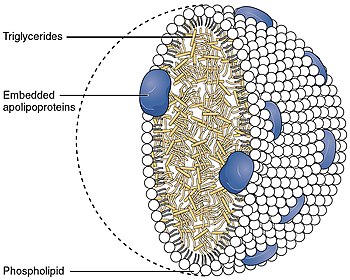Cholesteryl ester transfer protein
Ensembl |
| ||||||||
|---|---|---|---|---|---|---|---|---|---|
| UniProt |
| ||||||||
| RefSeq (mRNA) |
| ||||||||
| RefSeq (protein) |
| ||||||||
| Location (UCSC) | Chr 16: 56.96 – 56.98 Mb | n/a | |||||||
| PubMed search | [2] | n/a | |||||||
| View/Edit Human | |||
Cholesteryl ester transfer protein (CETP), also called plasma lipid transfer protein, is a
Genetics
The CETP gene is located on chromosome 16 (16q21).
Protein Fold
The
Role in disease
Rare mutations leading to reduced function of CETP have been linked to accelerated
Elaidic acid, a major component of trans fat, increases CETP activity.[15]
Pharmacology
As HDL can alleviate atherosclerosis and other cardiovascular diseases, and certain disease states such as the metabolic syndrome feature low HDL, pharmacological inhibition of CETP is being studied as a method of improving HDL levels.[16] To be specific, in a 2004 study, the small molecular agent torcetrapib was shown to increase HDL levels, alone and with a statin, and lower LDL when co-administered with a statin.[17] Studies into cardiovascular endpoints, however, were largely disappointing. While they confirmed the change in lipid levels, most reported an increase in blood pressure, no change in atherosclerosis,[18][19] and, in a trial of a combination of torcetrapib and atorvastatin, an increase in cardiovascular events and mortality.[20]
A compound related to torcetrapib, Dalcetrapib (investigative name JTT-705/R1658), was also studied, but trials have ceased.[21] It increases HDL levels by 30%, as compared to 60% by torcetrapib.[22] Two CETP inhibitors were previously under development. One was Merck's MK-0859 anacetrapib, which in initial studies did not increase blood pressure.[23] In 2017, its development was abandoned by Merck.[24] The other was Eli Lilly's evacetrapib, which failed in Phase 3 trials.
Interactive pathway map
Click on genes, proteins and metabolites below to link to respective articles. [§ 1]
- ^ The interactive pathway map can be edited at WikiPathways: "Statin_Pathway_WP430".
References
- ^ a b c GRCh38: Ensembl release 89: ENSG00000087237 – Ensembl, May 2017
- ^ "Human PubMed Reference:". National Center for Biotechnology Information, U.S. National Library of Medicine.
- S2CID 30939809.
- PMID 26825693.
- PMID 26686281.
- PMID 28554774.
- PMID 29042313.
- PMID 29067689.
- PMID 22961980.
- PMID 26876146.
- ^ PMID 8675707.
- S2CID 22792639.
- S2CID 260169359.
- PMID 9610775.
- PMID 8018112.
- PMID 12588754.
- PMID 15071125.
- PMID 17387129.
- PMID 17387131.
- ^ "Pfizer Stops All Torcetrapib Clinical Trials in Interest of Patient Safety" (Press release). U.S. Food and Drug Administration. 3 December 2006.
- PMID 17877921.
- PMID 11994249.
- ^ "Merck announces its investigational CETP-Inhibitor, MK-0859, produced positive effects on lipids with no observed blood pressure changes". Reuters. Reuters, Inc. 4 October 2007. Retrieved 26 November 2013.
- ^ "Merck says will not seek approval of cholesterol treatment". Reuters. 2017. Retrieved 18 October 2017.
Further reading
- Okajima F (March 2002). "[Distribution of sphingosine 1-phosphate in plasma lipoproteins and its role in the regulation of the vascular cell functions]". Tanpakushitsu Kakusan Koso. Protein, Nucleic Acid, Enzyme. 47 (4 Suppl): 480–7. PMID 11915346.
- Barter PJ, Brewer HB, Chapman MJ, Hennekens CH, Rader DJ, Tall AR (February 2003). "Cholesteryl ester transfer protein: a novel target for raising HDL and inhibiting atherosclerosis". Arteriosclerosis, Thrombosis, and Vascular Biology. 23 (2): 160–7. PMID 12588754.
- Dallinga-Thie GM, Dullaart RP, van Tol A (June 2007). "Concerted actions of cholesteryl ester transfer protein and phospholipid transfer protein in type 2 diabetes: effects of apolipoproteins". Current Opinion in Lipidology. 18 (3): 251–7. S2CID 20012553.
External links
- Cholesterol+ester+transfer+proteins at the U.S. National Library of Medicine Medical Subject Headings (MeSH)



